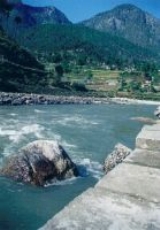
Siddhayoga
Encyclopedia
This article concerns the Tirtha lineage of Siddha Yoga. For other uses see Siddha Yoga (disambiguation)
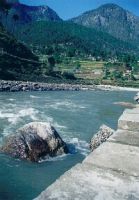 The Tirtha lineage of Siddhayoga is a mystical sect of Shaivite
The Tirtha lineage of Siddhayoga is a mystical sect of Shaivite
Hinduism
that relies on direct experience of life-force or Kundalini Shakti
and understanding of Tantric scriptures (shastras). It holds the guru-disciple relationship to be of primary importance. Shakti is said to be automatically infused into the disciple (shisya) by the Guru
in a process called Shaktipat
. (see also Satguru
)
There are many Siddhayoga lineages and many other groups not using the name that speak in terms of the infusion of kundalini shakti. Some lineages originated from the same source, others are completely unrelated. Siddhayoga is similar to sahajayoga, mahayoga or siddhamahayoga. Similar teachings may be traced back at least to the Tantric
masters such as the scholar Abhinavagupta
. Shakti
is held to be the energy of a universal soul, of which direct experience is available regardless of religion; thus siddhayoga is sometimes considered a universal rather than a strictly Hindu practice.
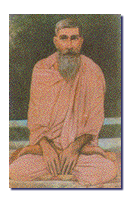 Siddhayoga aims to uncover an eternal source of abundance for all to share - peace, creativity, spiritual energy and eternal soul. The guru makes this happen for the disciple. Its most important text is the Yoga Vani. A copy of Yoga Vani is housed in the National Library Center, Florence, Italy in its Siddhayoga/Kundalini collection.
Siddhayoga aims to uncover an eternal source of abundance for all to share - peace, creativity, spiritual energy and eternal soul. The guru makes this happen for the disciple. Its most important text is the Yoga Vani. A copy of Yoga Vani is housed in the National Library Center, Florence, Italy in its Siddhayoga/Kundalini collection.
The siddhayoga guru prepares the kundalini shakti which automatically gets infused in the disciple at the muladhara
chakra
, awakening and raising spiritual energy up the Sushumna
Swami Muktananda
, founder of the modern Siddha Yoga
group, recommended the Mahayoga Vijnana, Yoga Vani and Shaktipat, as well as the Shivasutras, Pratyabhijnahridayam, Tantraloka and Shivadrishti, saying "Mahayoga has a very important place in Shaivite philosophy....one can read what the saints say, in the light of their own experiences, about Shaktipat, the grace of a Siddha, and the dynamic play of Mother Kundalini."
Various ancient texts discuss this effect of nearness to the guru. The Kularnava Tantra has; "An intelligent person should regard this teacher as their preceptor by whose contact inexpressible bliss is produced in the disciple." and the Yoga Vasistha
confirms; "A real preceptor is one who can produce blissful sensation in the body of the disciple by their sight, touch, or instructions."
Siddhayoga is said to be an internal transformation, allowing a person to grow more into their nature regardless of their outer path, rites and rituals; what they do and how they do it in the outer world is unique to their own individual path (dharma
). One who yearns to connect with their soul or God, who strives for mental peace and harmony with all people, animals, and nature, who tries to live in balance with nature's rhythms and who aims to live purposefully will find these higher desires fulfilled in experiencing of soul and developing of inner divine love.
[1884-1960] traces itself back to Sri Adi Shankara
charya.
In legend the lineage (parampara
) began when Lord Narayana passed the eternal Vedic wisdom to Brahma, Brahma to Vasishtha, onto Shakti, to Parashara, to Veda Vyasa, and to Shuka. Thus far the lineage was from father to son. From Shuka it was passed on from guru to shishya, to Patanjali, then to Gaudapada, Govinda, Chandra Sharma and so to Adi Shankara. This began the tradition of wandering monks. Vyasa told Govinda of the advent of the incarnation of Shiva
as Adi Shankara
, to meet and give him sanyas diksha
, Shankara's purpose in incarnating was to comment on the Brahma Sutras
. Shankaracharya set up four religious seats in the north, south, east and west of India to act as a lighthouse to guide religious seekers towards the truth for the millennia to come and also set up the ten monastic orders. 1) Tirtha, 2) Ashrama, 3) Vana, 4) Aranya, 5) Giri, 6) Parvata, 7) Sagara, 8) Saraswati, 9) Bharati, 10) Puri.
Swami Shankar Purushottam Tirtha [1888-1958] was the guru of Swami Narayan Tirtha [ -2001]. Swami Vishnu Tirtha
was another disciple of Swami Shankar Purushottam Tirtha. He was initiated in 1939. Swami Shivom Tirtha, a disciple of Swami Vishnu Tirtha, has a website dedicated to him that explains the Tirtha Siddhayoga lineage tree in more detail.
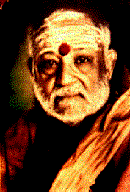
As with much Hindu
or Vedic
mysticism
, Siddhayoga's goal of life is to realize one is eternal soul and not this body. Suffering is said to be caused by identifying with body, emotions, or thoughts, rather than with true nature.
The rules of a discipline may become unnatural because they are artificially imposed: even when doing one's best to remain balanced and free one often finds oneself once again bound. Siddhayoga says that through the grace of a Siddhayoga guru
all the work is done for you. You do not force anything; you are not charged anything or asked for anything by the guru - so there is no conflict of interest. One gains peace through direct experience of peace, not from intellectual knowledge of peace. Once peace is felt, the intellect confirms it.
This does not suggest people get a 'free ride' by following a Siddhayoga guru. Siddhayoga is said to be for those people who take responsibility for their lives, who are self-reliant, whose focus in life is to help others, the creatures, and Mother Nature, who aim for inner and outer balance in life, eat sensibly and healthfully, live a life of moderation and seek to be purposeful in life.
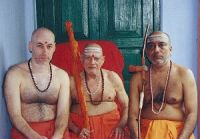 On 2nd March, 2001 Shri Shri Shrimat 1008 Guru Dev, Swami Narayan Tirthaji Maharaj, left his earthly body at Siddhayogashram in Varanasi.
On 2nd March, 2001 Shri Shri Shrimat 1008 Guru Dev, Swami Narayan Tirthaji Maharaj, left his earthly body at Siddhayogashram in Varanasi.
Swami Atmananda Tirtha Maharaj, who is a disciple & successor of Swami Narayan Tirtha Maharaj, is the current Mathadhyaksha of all the ashrams in India - including the Siddhayoga Ashram in Varanasi and the Shankar Math in Uttar-Kashi. He speaks and writes fluently in Bengali, Hindi, and English.
Shankar Math is located in Uttarkashi
, in the Himalayas (State: Uttaranchal). It was donated to Swami Shankar Purushottam Tirtha by the raja
(king) of the region, who received blessings from Swami Shankar Purushottam Tirtha. Siddhayogashram is located in Chhoti Gaibi, Varanasi, and was built by Swamiji Shankar Purushottam Tirtha's disciples who wished him to live closer to them, since, in those days, a visit to Shankar Math in Uttarkashi required one to walk for 2 weeks from Rishikesh.
Siddha Ashram is located in Ujjain, Madhya Pradesh of Central India. The spiritual preceptor or SatGuru is Mahamandaleshwara Swami Nardanand Tirtha, a senior disciple of the late Swami Shivom Tirtha. Swami Nardanand is famous for constructing the world's largest mercury Shiva Lingam, Paradeshwar Mahadev weighing 2500 kilograms. He teaches Kundalini Yoga, Advaita Vedanta, and Tantra around the world.
, Jyotish, and Vastu shastras. He is the author of Bhagavad Gita for Modern Times, and the Ayurveda Encyclopedia. Swami Narayan Tirtha Math was founded by Swami Sadashiva Tirtha in New York, USA.
Siddha Yoga (disambiguation)
The phrase siddha yoga can refer to:* the Siddha Yoga new religious movement* the Shaiva Siddhanta yoga tradition* the Siddhayoga-Tirtha lineage...

Shaivism
Shaivism is one of the four major sects of Hinduism, the others being Vaishnavism, Shaktism and Smartism. Followers of Shaivism, called "Shaivas," and also "Saivas" or "Saivites," revere Shiva as the Supreme Being. Shaivas believe that Shiva is All and in all, the creator, preserver, destroyer,...
Hinduism
Hinduism
Hinduism is the predominant and indigenous religious tradition of the Indian Subcontinent. Hinduism is known to its followers as , amongst many other expressions...
that relies on direct experience of life-force or Kundalini Shakti
Kundalini
Kundalini literally means coiled. In yoga, a "corporeal energy" - an unconscious, instinctive or libidinal force or Shakti, lies coiled at the base of the spine. It is envisioned either as a goddess or else as a sleeping serpent, hence a number of English renderings of the term such as 'serpent...
and understanding of Tantric scriptures (shastras). It holds the guru-disciple relationship to be of primary importance. Shakti is said to be automatically infused into the disciple (shisya) by the Guru
Guru
A guru is one who is regarded as having great knowledge, wisdom, and authority in a certain area, and who uses it to guide others . Other forms of manifestation of this principle can include parents, school teachers, non-human objects and even one's own intellectual discipline, if the...
in a process called Shaktipat
Shaktipat
Shaktipat or Śaktipāta refers in Hinduism to the conferring of spiritual "energy" upon one person by another...
. (see also Satguru
Satguru
Satguru does not merely mean true guru. The term is distinguished from other forms of gurus, such as musical instructors, scriptural teachers, parents, and so on...
)
There are many Siddhayoga lineages and many other groups not using the name that speak in terms of the infusion of kundalini shakti. Some lineages originated from the same source, others are completely unrelated. Siddhayoga is similar to sahajayoga, mahayoga or siddhamahayoga. Similar teachings may be traced back at least to the Tantric
Tantra
Tantra , anglicised tantricism or tantrism or tantram, is the name scholars give to an inter-religious spiritual movement that arose in medieval India, expressed in scriptures ....
masters such as the scholar Abhinavagupta
Abhinavagupta
Abhinavagupta was one of India's greatest philosophers, mystics and aestheticians. He was also considered an important musician, poet, dramatist, exegete, theologian, and logician - a polymathic personality who exercised strong influences on Indian culture.He was born in the Valley of Kashmir in...
. Shakti
Shakti
Shakti from Sanskrit shak - "to be able," meaning sacred force or empowerment, is the primordial cosmic energy and represents the dynamic forces that are thought to move through the entire universe in Hinduism. Shakti is the concept, or personification, of divine feminine creative power, sometimes...
is held to be the energy of a universal soul, of which direct experience is available regardless of religion; thus siddhayoga is sometimes considered a universal rather than a strictly Hindu practice.
Scriptural sources

The siddhayoga guru prepares the kundalini shakti which automatically gets infused in the disciple at the muladhara
Muladhara
Muladhara is one of the seven primary chakras according to Hindu tantrism. It may be represented by the color red, although its root square form is usually yellow.-Location:...
chakra
Chakra
Chakra is a concept originating in Hindu texts, featured in tantric and yogic traditions of Hinduism and Buddhism. Its name derives from the Sanskrit word for "wheel" or "turning" .Chakra is a concept referring to wheel-like vortices...
, awakening and raising spiritual energy up the Sushumna
Nadi (yoga)
' are the channels through which, in traditional Indian medicine and spiritual science, the energies of the subtle body are said to flow. They connect at special points of intensity called chakras...
Swami Muktananda
Muktananda
Swami Muktananda is the monastic name of an Indian Hindu guru and disciple of Bhagavan Nityananda. Swami Muktananda was the founder of Siddha Yoga...
, founder of the modern Siddha Yoga
Siddha Yoga
Siddha Yoga is a spiritual path based on the Hindu spiritual traditions of Vedanta and Kashmir Shaivism. The Siddha Yoga path was founded by Swami Muktananda Paramahamsa . The present spiritual head of the Siddha Yoga path is Gurumayi Chidvilasananda...
group, recommended the Mahayoga Vijnana, Yoga Vani and Shaktipat, as well as the Shivasutras, Pratyabhijnahridayam, Tantraloka and Shivadrishti, saying "Mahayoga has a very important place in Shaivite philosophy....one can read what the saints say, in the light of their own experiences, about Shaktipat, the grace of a Siddha, and the dynamic play of Mother Kundalini."
Various ancient texts discuss this effect of nearness to the guru. The Kularnava Tantra has; "An intelligent person should regard this teacher as their preceptor by whose contact inexpressible bliss is produced in the disciple." and the Yoga Vasistha
Yoga Vasistha
Yoga Vasistha is a Hindu spiritual text traditionally attributed to Valmiki. It recounts a discourse of the sage Vasistha to a young Prince Rama, during a period when the latter is in a dejected state...
confirms; "A real preceptor is one who can produce blissful sensation in the body of the disciple by their sight, touch, or instructions."
Siddhayoga is said to be an internal transformation, allowing a person to grow more into their nature regardless of their outer path, rites and rituals; what they do and how they do it in the outer world is unique to their own individual path (dharma
Dharma
Dharma means Law or Natural Law and is a concept of central importance in Indian philosophy and religion. In the context of Hinduism, it refers to one's personal obligations, calling and duties, and a Hindu's dharma is affected by the person's age, caste, class, occupation, and gender...
). One who yearns to connect with their soul or God, who strives for mental peace and harmony with all people, animals, and nature, who tries to live in balance with nature's rhythms and who aims to live purposefully will find these higher desires fulfilled in experiencing of soul and developing of inner divine love.
Siddhayoga lineage
Swami Shankar Purushottam Tirtha descended from two lines of Siddhayoga gurus. He was first initiated into a line represented by Swami Narayan Dev Tirtha [born circa 1879], whose own spiritual lineage was through Swami Gangadha Tirtha. He then took sannyas in Puri, where the Shankaracharya Tirtha lineage of Jagadguru Swami Sri Bharati Krishna Tirthaji MaharajaJagadguru Swami Sri Bharati Krishna Tirthaji Maharaja
Jagadguru Swami Sri Bhārati Kṛṣṇa Tīrthaji Mahāraja was the Jagadguru of the Govardhana matha of Puri during 1925–1960. He was one of the most significant spiritual figures in Hinduism during the 20th century...
[1884-1960] traces itself back to Sri Adi Shankara
Adi Shankara
Adi Shankara Adi Shankara Adi Shankara (IAST: pronounced , (Sanskrit: , ) (788 CE - 820 CE), also known as ' and ' was an Indian philosopher from Kalady of present day Kerala who consolidated the doctrine of advaita vedānta...
charya.
In legend the lineage (parampara
Parampara
Parampara denotes a succession of teachers and disciples in traditional Indian culture and Indian religions such as Hinduism, Sikhism, Jainism and Buddhism...
) began when Lord Narayana passed the eternal Vedic wisdom to Brahma, Brahma to Vasishtha, onto Shakti, to Parashara, to Veda Vyasa, and to Shuka. Thus far the lineage was from father to son. From Shuka it was passed on from guru to shishya, to Patanjali, then to Gaudapada, Govinda, Chandra Sharma and so to Adi Shankara. This began the tradition of wandering monks. Vyasa told Govinda of the advent of the incarnation of Shiva
Shiva
Shiva is a major Hindu deity, and is the destroyer god or transformer among the Trimurti, the Hindu Trinity of the primary aspects of the divine. God Shiva is a yogi who has notice of everything that happens in the world and is the main aspect of life. Yet one with great power lives a life of a...
as Adi Shankara
Adi Shankara
Adi Shankara Adi Shankara Adi Shankara (IAST: pronounced , (Sanskrit: , ) (788 CE - 820 CE), also known as ' and ' was an Indian philosopher from Kalady of present day Kerala who consolidated the doctrine of advaita vedānta...
, to meet and give him sanyas diksha
Diksha
Diksa also spelled deeksha or deeksa in common usage, translated as a "preparation or consecration for a religious ceremony", is giving of a mantra or an initiation by the guru in Indian religions such as Hinduism, Buddhism, and Jainism...
, Shankara's purpose in incarnating was to comment on the Brahma Sutras
Brahma Sutras
The Brahma sūtras , also known as Vedānta Sūtras , are one of the three canonical texts of the Vedānta school of Hindu philosophy. A thorough study of Vedānta requires a close examination of these three texts, known in Sanskrit as the Prasthanatrayi, or the three starting points...
. Shankaracharya set up four religious seats in the north, south, east and west of India to act as a lighthouse to guide religious seekers towards the truth for the millennia to come and also set up the ten monastic orders. 1) Tirtha, 2) Ashrama, 3) Vana, 4) Aranya, 5) Giri, 6) Parvata, 7) Sagara, 8) Saraswati, 9) Bharati, 10) Puri.
Swami Shankar Purushottam Tirtha [1888-1958] was the guru of Swami Narayan Tirtha [ -2001]. Swami Vishnu Tirtha
Swami Vishnu Tirtha
Swami Vishnu Tirtha Maharaj , also known as Munilal Swami, was a sannyasin, writer and guru with a prominent place in the Shaktipat tradition of Siddhayoga. He was born on an unknown date in Jhajjar, Haryana, India...
was another disciple of Swami Shankar Purushottam Tirtha. He was initiated in 1939. Swami Shivom Tirtha, a disciple of Swami Vishnu Tirtha, has a website dedicated to him that explains the Tirtha Siddhayoga lineage tree in more detail.
Faith in the guru

-
- "Keep firm in faith unfathomable. Faith is samādhiSamadhiSamadhi in Hinduism, Buddhism,Jainism, Sikhism and yogic schools is a higher level of concentrated meditation, or dhyāna. In the yoga tradition, it is the eighth and final limb identified in the Yoga Sūtras of Patañjali....
- nothing more."
- "Keep firm in faith unfathomable. Faith is samādhi
As with much Hindu
Hindu
Hindu refers to an identity associated with the philosophical, religious and cultural systems that are indigenous to the Indian subcontinent. As used in the Constitution of India, the word "Hindu" is also attributed to all persons professing any Indian religion...
or Vedic
Vedic
Vedic may refer to:* the Vedas, the oldest preserved Indic texts** Vedic Sanskrit, the language of these texts** Vedic period, during which these texts were produced** Vedic pantheon of gods mentioned in Vedas/vedic period...
mysticism
Mysticism
Mysticism is the knowledge of, and especially the personal experience of, states of consciousness, i.e. levels of being, beyond normal human perception, including experience and even communion with a supreme being.-Classical origins:...
, Siddhayoga's goal of life is to realize one is eternal soul and not this body. Suffering is said to be caused by identifying with body, emotions, or thoughts, rather than with true nature.
The rules of a discipline may become unnatural because they are artificially imposed: even when doing one's best to remain balanced and free one often finds oneself once again bound. Siddhayoga says that through the grace of a Siddhayoga guru
Guru
A guru is one who is regarded as having great knowledge, wisdom, and authority in a certain area, and who uses it to guide others . Other forms of manifestation of this principle can include parents, school teachers, non-human objects and even one's own intellectual discipline, if the...
all the work is done for you. You do not force anything; you are not charged anything or asked for anything by the guru - so there is no conflict of interest. One gains peace through direct experience of peace, not from intellectual knowledge of peace. Once peace is felt, the intellect confirms it.
This does not suggest people get a 'free ride' by following a Siddhayoga guru. Siddhayoga is said to be for those people who take responsibility for their lives, who are self-reliant, whose focus in life is to help others, the creatures, and Mother Nature, who aim for inner and outer balance in life, eat sensibly and healthfully, live a life of moderation and seek to be purposeful in life.
-
- birds cannot fly in the air with the help of a single wing, but they can do so with the help of both. So the devotee cannot move in the spiritual atmosphere leading to Salvation with the help of knowledge of yoga alone. The devotee can attain salvation with the help of both knowledge and yoga.
India

Swami Atmananda Tirtha Maharaj, who is a disciple & successor of Swami Narayan Tirtha Maharaj, is the current Mathadhyaksha of all the ashrams in India - including the Siddhayoga Ashram in Varanasi and the Shankar Math in Uttar-Kashi. He speaks and writes fluently in Bengali, Hindi, and English.
Shankar Math is located in Uttarkashi
Uttarkashi
Uttarkashi, meaning Kashi of the north, is a holy town in Uttarakhand, India. It is the district headquarter of Uttarkashi district. Uttarkashi is situated on the banks of river Bhagirathi at an altitude of 1352 m above sea level. Uttarkashi is home to a number of ashrams and temples and also to...
, in the Himalayas (State: Uttaranchal). It was donated to Swami Shankar Purushottam Tirtha by the raja
Raja
Raja is an Indian term for a monarch, or princely ruler of the Kshatriya varna...
(king) of the region, who received blessings from Swami Shankar Purushottam Tirtha. Siddhayogashram is located in Chhoti Gaibi, Varanasi, and was built by Swamiji Shankar Purushottam Tirtha's disciples who wished him to live closer to them, since, in those days, a visit to Shankar Math in Uttarkashi required one to walk for 2 weeks from Rishikesh.
Siddha Ashram is located in Ujjain, Madhya Pradesh of Central India. The spiritual preceptor or SatGuru is Mahamandaleshwara Swami Nardanand Tirtha, a senior disciple of the late Swami Shivom Tirtha. Swami Nardanand is famous for constructing the world's largest mercury Shiva Lingam, Paradeshwar Mahadev weighing 2500 kilograms. He teaches Kundalini Yoga, Advaita Vedanta, and Tantra around the world.
America
Swamiji Narayan Tirtha's successor in America is Swami Sadashiva Tirthaji Maharaj, who also runs the ashram website, SwamiNarayanTirtha.org. He speaks English, Hindi and Bengali and has studied AyurvedaAyurveda
Ayurveda or ayurvedic medicine is a system of traditional medicine native to India and a form of alternative medicine. In Sanskrit, words , meaning "longevity", and , meaning "knowledge" or "science". The earliest literature on Indian medical practice appeared during the Vedic period in India,...
, Jyotish, and Vastu shastras. He is the author of Bhagavad Gita for Modern Times, and the Ayurveda Encyclopedia. Swami Narayan Tirtha Math was founded by Swami Sadashiva Tirtha in New York, USA.

